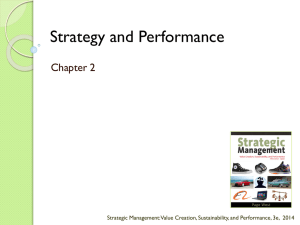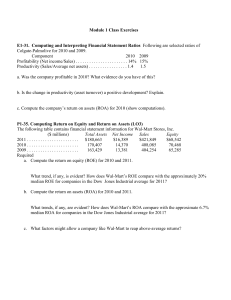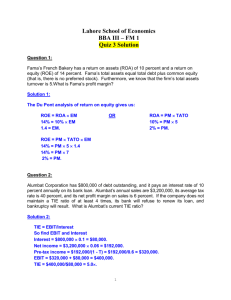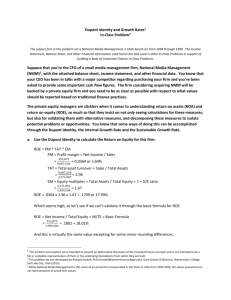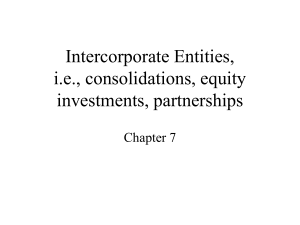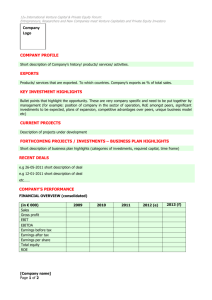Chapter 6
advertisement
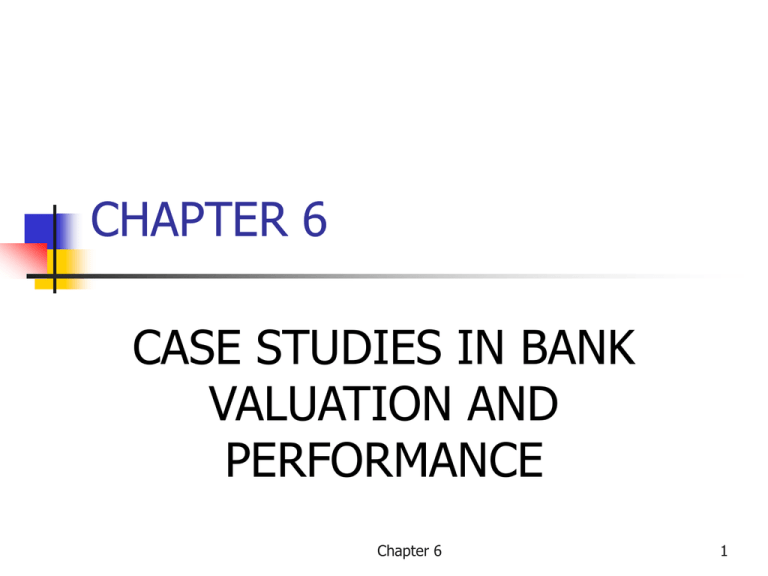
CHAPTER 6 CASE STUDIES IN BANK VALUATION AND PERFORMANCE Chapter 6 1 LEARNING OBJECTIVES To apply accounting and market performance measures to various financial and bank holding companies, banks, and other financial-services firms To understand the financial statements and unique financial characteristics of various financial and bank holding companies, banks, and other financialservices firms Chapter 6 2 CHAPTER THEME In 1974, a noted bank-stock analyst said, regarding the first billion-dollar bank failure in the U.S., “People who can read a balance sheet were out of there long ago.” A self-serving statement for sure for an analyst of bank stocks Chapter 6 3 How To Read a Balance Sheet (and other financial statements) It’s important to the various stakeholders in a bank including Owners/directors/managers Creditors (uninsured vs. insured) Safety-net managers (regulators and deposit insurers) Analysts and rating agencies Chapter 6 4 Analyzing Bank/BHC Financial Statements: Approaches and Caveats “du Pont” model -- ROE decomposition analysis ROE = PM x AU x EM Pro-Forma Analysis (forecasting) Chapter 6 5 Analyzing Bank/BHC Financial Statements: Approaches and Caveats Four Pieces of Accounting Data Needed to Start ROE Analysis Net Income (profits) Total Operating Income (“sales”) Total Assets Total Equity Capital Chapter 6 6 Analyzing Bank/BHC Financial Statements: Approaches and Caveats Ratio Components of the ROE Model ROE = Net Income / Equity Capital ROA = Net Income / Total Assets PM = Net Income / Operating Income AU = Operating Income / Total Assets EM = Total Assets / Equity Capital Chapter 6 7 Exercises For the case studies that follow, if the companies still exist, find the most recent accounting data and, if available, market data and determine how the company has performed compared to the data presented here Chapter 6 8 Citigroup The Largest FHC in the United States Overview of holding company (3-31-00) Unit Assets Net inc. ROA Citicorp 400.1 8.580 2.15% Salomon 226.7 3.952 1.74 Travelers 107.3 2.094 1.95 Citigroup 738.2 14.360 1.95% Note: $ billions for assets and NI Chapter 6 9 Overview of Travelers (3-31-00) Unit Assets Net inc. ROA Ins. Co. 67.9 0.704 1.04% Life&Annuity 8.5 0.066 0.78 P&C Corp. 30.9 1.324 4.28 Citigroup 107.3 2.094 1.95% Note: $ billions for assets and NI Chapter 6 10 Citigroup The Largest FHC in the United States Total Assets = 738,205 Total Equity Capital = 50,326 Total Operating Income = 95,448 Net Income = 14,360 ($ Millions, March 31, 2000) Chapter 6 11 Citigroup The Largest FHC in the United States ROE = 0.2853 = 0.0195 x 14.67 ROA = 0.0195 = 0.1504 x 0.1293 PM = 0.1504 AU = 0.1293 EM = 14.67 Chapter 6 12 Bank of America The Largest BHC in the United States Total Assets = 656,113 Total Equity Capital = 45,299 Total Operating Income = 56,528 Net Income = 8,960 ($ Millions, 3-31-00) Chapter 6 13 Bank of America The Largest BHC in the United States ROE = 0.1978 = 0.01367 x 14.48 ROA = 0.0137 = 0.1558 x 0.0862 PM = 0.1585 AU = 0.0862 EM = 14.48 Chapter 6 14 Keycorp A Superregional BHC Total Assets = 84,412 Total Equity Capital = 6,507 Total Operating Income = 2,186 Net Income = 1,229 ($ Millions, 6-30-00) Chapter 6 15 Keycorp A Superregional BHC ROE = 0.1889 = 0.0146 x 12.97 ROA = 0.0146 = 0.2049 x 0.0711 PM = 0.2049 AU = 0.0711 EM = 12.97 Chapter 6 16 Compass Bancshares A Regional BHC Total Assets = 18.972 Total Equity Capital = 1.325 Total Operating Income = 1.950 Net Income = 0.191 ($ Millions, 6-30-00) Chapter 6 17 Compass Bancshares A Regional BHC ROE = 0.1442 = 0.0101 x 14.32 ROA = 0.0101 = 0.0979 x 0.1028 PM = 0.0979 AU = 0.1028 EM = 14.32 Chapter 6 18 Market Data The preceding banking companies have market data available while the ones that follow do not Tables 6-3 (p. 165) and 6-6 (p. 171) show some of the variables based on market data that can be used to assess bank performance Chapter 6 19 Variables for Market Profiles Stock price (P) Market capitalization (P x N, where N = number of shares outstanding) EPS, DPS, and dividend yield (DPS/P) and payout [DPS/(EPS + DPS)] P/E (P/EPS) and market-to-book ratios Beta Holding-period return (HPR) Chapter 6 20 First American Bank & Trust A Community Bank Total Assets = 163.999 Total Equity Capital = 17.722 Total Operating Income = 13.346 Net Income = 2.016 ($ Millions, 3-31-00) Chapter 6 21 First American Bank & Trust A Community Bank ROE = 0.1138 = 0.0123 x 9.254 ROA = 0.0123 = 0.15 x 0.0814 PM = 0.15 AU = 0.0814 EM = 9.254 Chapter 6 22 Citizens Trust Bank A Minority - Owned Bank Total Assets = 252.736 Total Equity Capital = 19.243 Total Operating Income = 24.294 Net Income = 3.042 ($ Millions, 6-30-00) Note: Correction on p. 177 of the text: flow data should read with decimals point not commas Chapter 6 23 Citizens Trust Bank A Minority - Owned Bank ROE = 0.1581 = 0.0120 x 13.13 ROA = 0.0120 = 0.1252 x 0.0961 PM = 0.1252 AU = 0.0961 EM = 13.13 Note: Typo on p. 177 of the text, ROE is 0.1581 as shown above and not 0.1768 Chapter 6 24 NetBank A Pure-Internet Savings Bank Total Assets = 1,225 Total Equity Capital = 218 Total Operating Income = 21.302 Net Income = 0.408 ($ Millions, 12-31-99) Chapter 6 25 NetBank A Pure-Internet Savings Bank ROE = 0.0019 = 0.0003 x 5.76 ROA = 0.0003 = 0.0192 x 0.017 PM = 0.0192 AU = 0.017 EM = 5.76 Chapter 6 26 Bankers’ Banks and The Bankers Bank: A Correspondent-Banking Innovation Qualifications to be a Bankers’ Bank 1. Be organized solely to do business with other financial institutions 2. Be owned primarily by the financial institutions with which it does business 3. Not do business with the general public Chapter 6 27 Bankers’ Banks and The Bankers Bank: A Correspondent-Banking Innovation Total Assets = 840.414 Total Equity Capital = 48.694 Total Operating Income = 76.812 Net Income = 4.168 ($ Millions, 3-31-00) Chapter 6 28 Bankers’ Banks and The Bankers Bank: A Correspondent-Banking Innovation ROE = 0.0856 = 0.005 x 17.26 ROA = 0.0050 = 0.0543 x 0.0914 PM = 0.0543 AU = 0.0914 EM = 17.26 Chapter 6 29 Decision-Making Lessons On a pre-tax basis, ROA is driven by three key factors: 1. Net interest income or its ratio net interest margin (NIM) – the efficiency of the intermediation business 2. Provision for loan loss – loan quality 3. Net noninterest income (“burden”) – the efficiency of operations and fee generation Chapter 6 30 Decision-Making Lessons (continued) A bank’s portfolio and related cash flows drive its market performance Investors focus on the timing, size, and riskiness of future cash flows and what they are worth today (present value) Banks that mismanage credit risk have a difficult maximizing shareholder value Chapter 6 31 CHAPTER SUMMARY From a giant FHC, like Citigroup, down to the thousands of community banks, the ROE model provides an analytical framework for analyzing bank performance based on accounting data When available, market data provide more timely and accurate measures of bank performance Chapter 6 32
